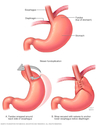GORD Flashcards
Define Gastro-Oesophageal Reflux Disease
symptoms or complications resulting from the reflux of gastric contents into the oesophagus or beyond, into the oral cavity (including larynx) or lung
Explain the aetiology/risk factors of GORD
RISK FACTORS:
- Family history of GORD/Heartburn
- Hiatus Hernia (reducing competence of the gastro-oesophageal junction and inhibiting clearance of oesophageal acid post-reflux)
- Obesity
AETIOLOGY/PATHOPHYSIOLOGY
- Episodes of transient lower oesophageal sphincter relaxation are a normal phenomenon, but they occur more frequently in GORD, causing reflux of gastric contents into the oesophagus.
- Transient lower oesophageal sphincter relaxation is more common after meals and is stimulated by fat in the duodenum.
- Patients with severe reflux often have a hiatus hernia and decreased resting lower oesophageal sphincter pressure.
- The duration of contact with gastric contents depends on the number of episodes of reflux, the efficacy of oesophageal peristalsis, and the neutralisation of acid by saliva
Summarise the epidemiology of gastro-oesophageal reflux disease
- COMMON
- 5-10% of adults
Recognise the presenting symptoms of gastro-oesophageal reflux disease
- Substernal/epigastric burning discomfort or ‘heartburn’ that is ggravated by:
- Lying supine
- Bending
- After Large meals (esp. fatty & spicy)
- Drinking alcohol
- Pain is relieved by antacids
- Sour/bitter taste in mouth
- Waterbrash (regurgitation of an excessive accumulation of saliva from the lower part of the oesophagus often mixed with some acid material from the stomach)
- Dysphagia - caused by the formation of peptic stricture after long-standing reflux
- Chronic dry cough
Recognise the signs of GORD on physical examination
- Usually NORMAL
- Occasionally - epigastric tenderness, wheeze on chest auscultation, dysphonia
Identify appropriate investigations for GORD and interpret the results
- Often a CLINICAL diagnosis
- If suspected: a trial of PPI is given
- If GORD persists: upper GI endoscopy and biopsy (confirms presence of oesophagitis and can exclude malignancy – must exclude for all >55 years)
- Other tests: 24h pH monitoring, manometry, barium swallow X-Ray
Generate a management plan for GORD
- Advice:
- Weight loss
- Elevating head of bed
- Avoid provoking factors (Lower fat meals, Avoid large meals late in the evening)
- Stop smoking
- Medical:
- Antacids/Alginates (e.g. Gaviscon)
- H2 antagonists (e.g. ranitidine)
- PPI (e.g. lansoprazole, omeprazole)
- Endoscopy:
- Annual endoscopic surveillance - looking for Barrett’s Oesophagus
- May be necessary for stricture dilation or stenting
- Surgery:
-
Nissen Fundoplication:
- Fundus of the stomach is wrapped around the lower oesophagus - helps reduce the risk of hiatus hernia and reduce reflux

Identify the possible complications of gastro-oesophageal reflux disease and its management
- Oesophageal ulceration
- Peptic stricture
- Anaemia
- Barrett’s oesophagus
- Oesophageal adenocarcinoma (rare)
- Associated with asthma and chronic laryngitis
Summarise the prognosis for patients with gastro-oesophageal reflux disease
- 50% respond to lifestyle measures alone
- In patients that require drug therapy, withdrawal is often associated with relapse
- 20% of patients undergoing endoscopy for GORD have Barrett’s oesophagus


